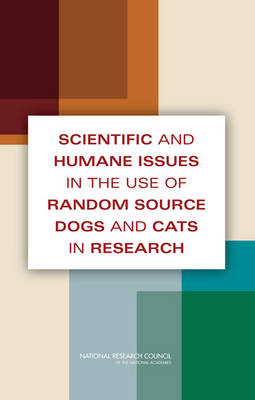
Scientific and Humane Issues in the Use of Random Source Dogs and Cats in Research
Seiten
2009
National Academies Press (Verlag)
978-0-309-13807-9 (ISBN)
National Academies Press (Verlag)
978-0-309-13807-9 (ISBN)
Scientific and Humane Issues in the Use of Random-Source Dogs and Cats in Research examines the value of random-source animals in biomedical research and the role of Class B dealers who acquire and resell live dogs and cats to research institutions. Findings include that, while some random-source dogs and cats may be necessary and desirable for National Institutes of Health (NIH)-funded research, there is no clear need to obtain those animals from Class B dealers. Several options for random-source animal acquisition already exist and additional options are recommended, which would further ensure the welfare of these animals and foster a positive public image for NIH.
While the scientific community has recognized and responded to concerns for humane treatment of animals in research, government oversight has thus far been unable to fully enforce the Animal Welfare Act in regard to Class B dealers of live animals. Although the animals acquired by Class B dealers are destined for research—and NIH research in particular—the standard of care while in the possession of some Class B dealers requires an inordinate amount of government enforcement and is not commensurate with the policies of most NIH-funded research laboratories. This dichotomy of standards reflects poorly on public perceptions of NIH and jeopardizes animal welfare.
This book will be crucial for NIH and other groups using random-source animals in research, including veterinary schools and research facilities. Animal welfare advocates, policy makers, and concerned pet owners will also find this a vital and informative work for reconciling the needs of research with the welfare of animals.
Table of Contents
Front Matter
Summary
1 Introduction
2 Use of Dogs and Cats in Research: Public Perception and Evolution of Laws and Guidelines
3 Use of Random Source Dogs and Cats for Research
4 Class B Dealers and Animals
5 Conclusions and Recommendations
Appendix: Committee Biographies
While the scientific community has recognized and responded to concerns for humane treatment of animals in research, government oversight has thus far been unable to fully enforce the Animal Welfare Act in regard to Class B dealers of live animals. Although the animals acquired by Class B dealers are destined for research—and NIH research in particular—the standard of care while in the possession of some Class B dealers requires an inordinate amount of government enforcement and is not commensurate with the policies of most NIH-funded research laboratories. This dichotomy of standards reflects poorly on public perceptions of NIH and jeopardizes animal welfare.
This book will be crucial for NIH and other groups using random-source animals in research, including veterinary schools and research facilities. Animal welfare advocates, policy makers, and concerned pet owners will also find this a vital and informative work for reconciling the needs of research with the welfare of animals.
Table of Contents
Front Matter
Summary
1 Introduction
2 Use of Dogs and Cats in Research: Public Perception and Evolution of Laws and Guidelines
3 Use of Random Source Dogs and Cats for Research
4 Class B Dealers and Animals
5 Conclusions and Recommendations
Appendix: Committee Biographies
1 Front Matter; 2 Summary; 3 1 Introduction; 4 2 Use of Dogs and Cats in Research: Public Perception and Evolution of Laws and Guidelines; 5 3 Use of Random Source Dogs and Cats for Research; 6 4 Class B Dealers and Animals; 7 5 Conclusions and Recommendations; 8 Appendix: Committee Biographies
| Erscheint lt. Verlag | 30.12.2009 |
|---|---|
| Verlagsort | Washington |
| Sprache | englisch |
| Maße | 152 x 229 mm |
| Themenwelt | Medizin / Pharmazie ► Medizinische Fachgebiete ► Laboratoriumsmedizin |
| Medizin / Pharmazie ► Medizinische Fachgebiete ► Medizinethik | |
| Studium ► Querschnittsbereiche ► Geschichte / Ethik der Medizin | |
| Sozialwissenschaften ► Soziologie | |
| ISBN-10 | 0-309-13807-8 / 0309138078 |
| ISBN-13 | 978-0-309-13807-9 / 9780309138079 |
| Zustand | Neuware |
| Haben Sie eine Frage zum Produkt? |
Mehr entdecken
aus dem Bereich
aus dem Bereich
Die Geschichte eines Weltzentrums der Medizin von 1710 bis zur …
Buch | Softcover (2021)
Lehmanns Media (Verlag)
CHF 27,90
Krankheitslehren, Irrwege, Behandlungsformen
Buch | Softcover (2024)
C.H.Beck (Verlag)
CHF 55,90


